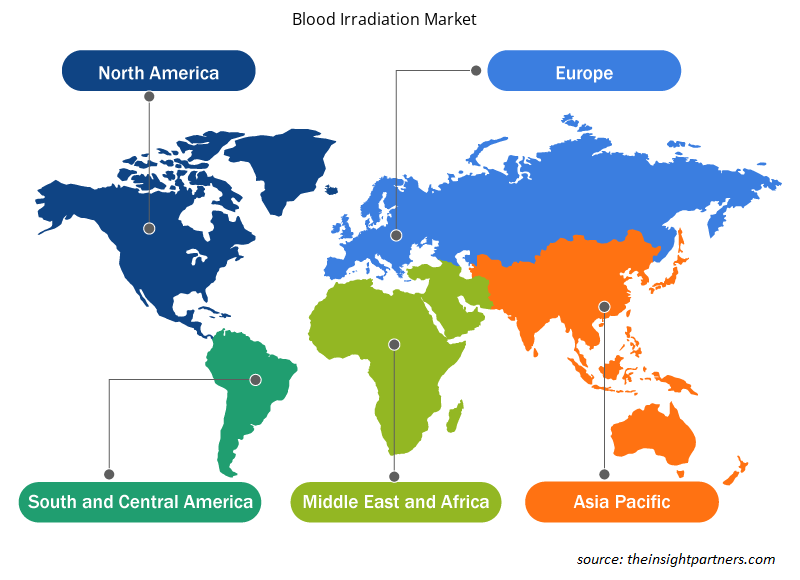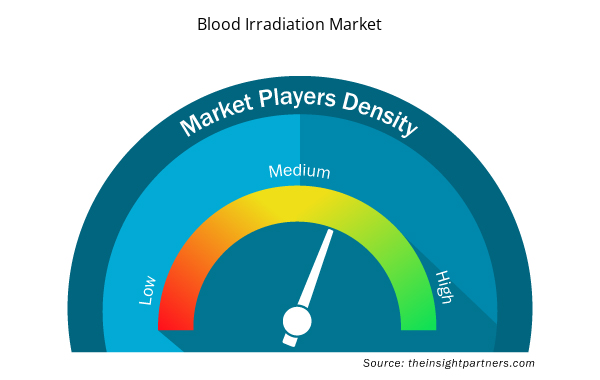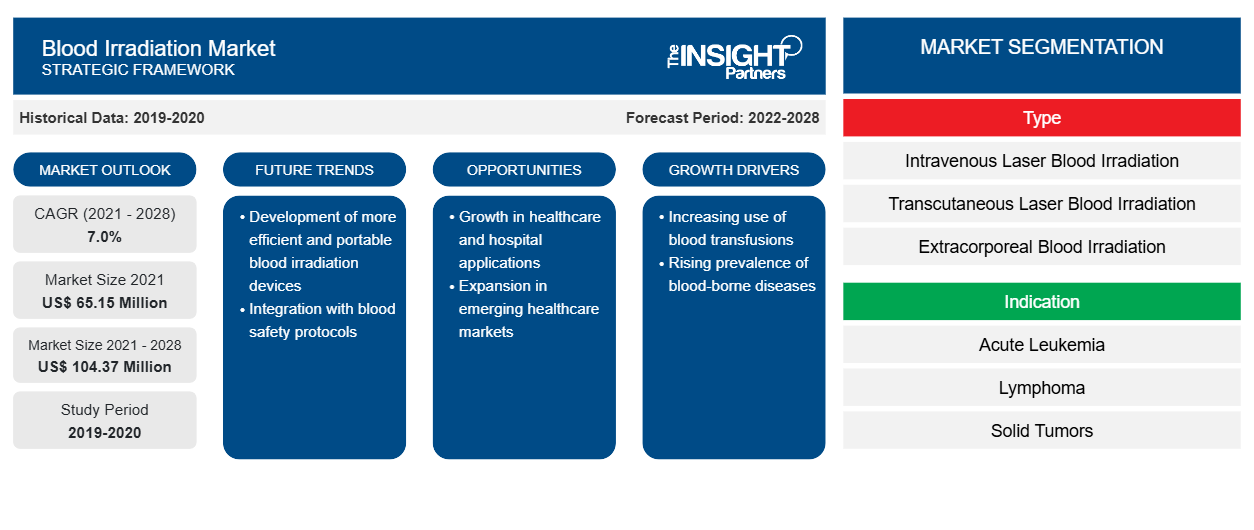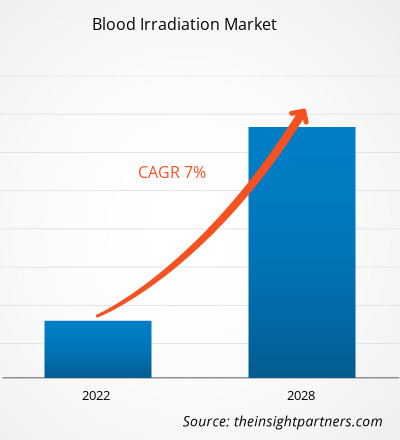Der Markt für Blutbestrahlung soll von 65,15 Millionen US-Dollar im Jahr 2021 auf 104,37 Millionen US-Dollar im Jahr 2028 anwachsen; von 2022 bis 2028 wird ein durchschnittliches jährliches Wachstum von 7,0 % erwartet.
Die steigende Prävalenz übertragbarer und nicht übertragbarer Krankheiten sowie zunehmende Forschung und Entwicklung treiben das Marktwachstum voran. Die hohen Kosten der Blutbestrahlung schränken das Marktwachstum jedoch ein.
Die Bestrahlung des Blutes erfolgt durch Bestrahlung des Blutes mit mindestens 25 Gy (2500 cGy) in der Mitte des Gefäßes. Dadurch wird die Replikation und Einnistung immunologisch kompetenter T-Leukozyten des Spenders in den Empfänger verhindert. Eine durch Spendertransplantate hervorgerufene GvHD verläuft fast immer tödlich, daher sollten gefährdete Patienten, soweit Zeit und Ressourcen es erlauben, bestrahlte Blutprodukte erhalten. Bei verschiedenen klinischen Indikationen ist eine Blutbestrahlung erforderlich. Dazu zählen akute Leukämie , Lymphome, solide Tumoren, die eine intensive Chemotherapie oder Strahlentherapie erhalten , Austauschtransfusionen, Organtransplantatempfänger und Frühgeborene. Patienten, die am humanen Immundefizienz-Virus/erworbenen Immunschwächesyndrom erkrankt sind, benötigen keine Bestrahlung ihrer Blutprodukte, da bei ihnen keine Anfälligkeit für eine posttransfusionsbedingte Graft-to-Host-Erkrankung vorliegt.
Passen Sie diesen Bericht Ihren Anforderungen an
Sie erhalten kostenlos individuelle Anpassungen an jedem Bericht, einschließlich Teilen dieses Berichts oder einer Analyse auf Länderebene, eines Excel-Datenpakets sowie tolle Angebote und Rabatte für Start-ups und Universitäten.
- Holen Sie sich die wichtigsten Markttrends aus diesem Bericht.Dieses KOSTENLOSE Beispiel umfasst eine Datenanalyse von Markttrends bis hin zu Schätzungen und Prognosen.
Markteinblicke
Zunahme übertragbarer und nicht übertragbarer Krankheiten treibt Marktwachstum an
Die Zahl der übertragbaren und nicht übertragbaren Krankheiten, darunter Krebs, Herz-Kreislauf-Erkrankungen, chronische Nierenerkrankungen und Schlaganfälle, nimmt zu, da weltweit viele Menschen anfällig für derartige Krankheiten sind. Laut der Weltgesundheitsorganisation (WHO) sind Herz-Kreislauf-Erkrankungen weltweit die häufigste Todesursache. Jährlich werden etwa 17,9 Millionen Todesfälle gemeldet. Darüber hinaus treibt die steigende Verbreitung übertragbarer Krankheiten wie Hepatitis, Grippe, das Humane Immundefizienz-Virus (HIV) und das erworbene Immunschwächesyndrom (AIDS) das Wachstum des Marktes für Blutbestrahlung voran . Laut WHO waren im Jahr 2020 325 Millionen Menschen mit dem Hepatitis-B-Virus infiziert, und jedes Jahr sterben 900.000 Menschen an einer Infektion mit dem Hepatitis-B-Virus. Darüber hinaus trägt die große geriatrische Bevölkerung weltweit zur Verbreitung nicht übertragbarer Krankheiten wie Herz-Kreislauf-Erkrankungen, Nierenerkrankungen und Schlaganfällen bei. Laut WHO betrug die Bevölkerung der über 60-Jährigen im Jahr 2019 eine Milliarde und dürfte bis 2030 auf 1,4 Milliarden und bis 2050 auf 2,1 Milliarden ansteigen. Die ältere Bevölkerung ist aufgrund verschiedener Faktoren wie schlechter Ernährung, mangelnder körperlicher Aktivität, übermäßigem Tabak- und Alkoholkonsum anfällig für nicht übertragbare Krankheiten.
Darüber hinaus unterstützt die steigende Zahl von Bluttransfusionen aufgrund der Zunahme von chirurgischen Eingriffen, Unfällen, Traumata und Erkrankungen sowie der steigenden Prävalenz von Blutstrominfektionen das Marktwachstum. Blutstrominfektionen, Grunderkrankungen und invasive Eingriffe sind bei der geriatrischen Bevölkerung weit verbreitet. Blutstrominfektionen sind die Hauptursache für Krankheit und Tod in großen Bevölkerungsgruppen. Laut der National Library of Medicine treten weltweit jährlich etwa 28.000 Blutstrominfektionen auf. Darüber hinaus können das steigende Bewusstsein für Blutstrominfektionen und die zunehmenden Immunreaktionen auf transfundiertes Blut Komplikationen verursachen, da der zunehmende Einsatz von bestrahltem Blut in der Krebsbehandlung das Immunsystem stärkt und die allgemeine Gesundheit der Patienten verbessert, was das Wachstum des Marktes für Blutbestrahlung vorantreibt.
Der Anstieg an übertragbaren und nicht übertragbaren Krankheiten, die Zunahme von Bluttransfusionen, die sprunghaft ansteigende Zahl von Blutbahninfektionen und die Zunahme von Immunreaktionen treiben das Wachstum des Marktes für Blutbestrahlung voran.
Typbasierte Erkenntnisse
Der Markt für Blutbestrahlung ist je nach Typ in intravenöse Laserblutbestrahlung, transkutane Laserblutbestrahlung und extrakorporale Blutbestrahlung unterteilt. Im Jahr 2021 hatte das Segment der intravenösen Laserblutbestrahlung den größten Marktanteil. Es wird jedoch erwartet, dass das Segment der extrakorporalen Laserblutbestrahlung im Prognosezeitraum die höchste durchschnittliche jährliche Wachstumsrate von 7,8 % verzeichnet.
Endbenutzerbasierte Erkenntnisse
Basierend auf dem Endverbraucher ist der Markt für Blutbestrahlung in Krankenhäuser, Blutbanken , Diagnosekliniken und Forschungsinstitute unterteilt. Das Krankenhaussegment hatte 2021 den größten Marktanteil. Es wird jedoch geschätzt, dass das Blutbanksegment im Prognosezeitraum mit 7,7 % die höchste durchschnittliche jährliche Wachstumsrate auf dem Markt verzeichnet.
Regionale Einblicke in den Markt für Blutbestrahlung
Die regionalen Trends und Faktoren, die den Markt für Blutbestrahlung im Prognosezeitraum beeinflussen, wurden von den Analysten von Insight Partners ausführlich erläutert. In diesem Abschnitt werden auch die Marktsegmente und die Geografie für Blutbestrahlung in Nordamerika, Europa, im asiatisch-pazifischen Raum, im Nahen Osten und Afrika sowie in Süd- und Mittelamerika erörtert.

- Erhalten Sie regionale Daten zum Blutbestrahlungsmarkt
Umfang des Marktberichts zur Blutbestrahlung
| Berichtsattribut | Details |
|---|---|
| Marktgröße im Jahr 2021 | 65,15 Millionen US-Dollar |
| Marktgröße bis 2028 | 104,37 Millionen US-Dollar |
| Globale CAGR (2021 - 2028) | 7,0 % |
| Historische Daten | 2019-2020 |
| Prognosezeitraum | 2022–2028 |
| Abgedeckte Segmente | Nach Typ
|
| Abgedeckte Regionen und Länder | Nordamerika
|
| Marktführer und wichtige Unternehmensprofile |
|
Marktteilnehmerdichte: Der Einfluss auf die Geschäftsdynamik
Der Markt für Blutbestrahlung wächst rasant, angetrieben durch die steigende Nachfrage der Endnutzer aufgrund von Faktoren wie sich entwickelnden Verbraucherpräferenzen, technologischen Fortschritten und einem größeren Bewusstsein für die Vorteile des Produkts. Mit steigender Nachfrage erweitern Unternehmen ihr Angebot, entwickeln Innovationen, um die Bedürfnisse der Verbraucher zu erfüllen, und nutzen neue Trends, was das Marktwachstum weiter ankurbelt.
Die Marktteilnehmerdichte bezieht sich auf die Verteilung von Firmen oder Unternehmen, die in einem bestimmten Markt oder einer bestimmten Branche tätig sind. Sie gibt an, wie viele Wettbewerber (Marktteilnehmer) in einem bestimmten Marktraum im Verhältnis zu seiner Größe oder seinem gesamten Marktwert präsent sind.
Die wichtigsten auf dem Markt für Blutbestrahlung tätigen Unternehmen sind:
- Typenex Medical, LLC
- Hitachi Medical Systems
- Rad Source Technologies
- Gilardoni SpA
- Gamma-Service Medical GmbH
Haftungsausschluss : Die oben aufgeführten Unternehmen sind nicht in einer bestimmten Reihenfolge aufgeführt.

- Überblick über die wichtigsten Akteure auf dem Markt für Blutbestrahlung
Indikationsbasierte Erkenntnisse
Nach Indikation ist der Markt für Blutbestrahlung in akute Leukämie, solide Tumore, Beckentumore, Lymphome und andere unterteilt. Das Segment akute Leukämie hatte 2021 den größten Marktanteil. Es wird jedoch geschätzt, dass das Segment Lymphome im Prognosezeitraum die höchste durchschnittliche jährliche Wachstumsrate von 8,8 % auf dem Markt verzeichnet.
Unternehmen, die auf dem Markt für Blutbestrahlung tätig sind, verfolgen die Strategie der Produktinnovation, um den sich entwickelnden Kundenanforderungen auf der ganzen Welt gerecht zu werden, was es ihnen auch ermöglicht, ihren Markennamen auf dem Weltmarkt zu behaupten. So entwickelte beispielsweise Rad Source Technologies, ein kommerzieller Anbieter von Röntgenstrahlungsprodukten in den USA, im Juni 2021 ein Produkt, das selbstabschirmende Gammabestrahlungsgeräte ersetzen soll, und stellte auf der MEDLAB Middle East 2021 seinen neu gestalteten Blutbestrahlungsapparat RS 3400 vor.
Markt für Blutbestrahlung – nach Geografie
Geografisch ist der Markt für Blutbestrahlung segmentiert in Nordamerika (USA, Kanada und Mexiko), Europa (Frankreich, Deutschland, Großbritannien, Spanien, Italien und übriges Europa), Asien-Pazifik (China, Indien, Japan, Australien, Südkorea und übriger Asien-Pazifik-Raum), Naher Osten und Afrika (Saudi-Arabien, Vereinigte Arabische Emirate, Südafrika und übriger Naher Osten und Afrika) sowie Süd- und Mittelamerika (Brasilien, Argentinien und übriges Süd- und Mittelamerika). Zu den in der Forschungsstudie berücksichtigten Marktteilnehmern gehören Typenex Medical, LLC; Hitachi Medical Systems; Rad Source Technologies; Gilardoni SpA; Gamma-Service Medical GmbH; Actemium; und Best Theratronics Ltd.
- Historische Analyse (2 Jahre), Basisjahr, Prognose (7 Jahre) mit CAGR
- PEST- und SWOT-Analyse
- Marktgröße Wert/Volumen – Global, Regional, Land
- Branche und Wettbewerbsumfeld
- Excel-Datensatz


- High Speed Cable Market
- Wind Turbine Composites Market
- Photo Printing Market
- Malaria Treatment Market
- Procedure Trays Market
- Artificial Intelligence in Healthcare Diagnosis Market
- Medical and Research Grade Collagen Market
- Queue Management System Market
- Joint Pain Injection Market
- Automotive Fabric Market

Report Coverage
Revenue forecast, Company Analysis, Industry landscape, Growth factors, and Trends

Segment Covered
This text is related
to segments covered.

Regional Scope
North America, Europe, Asia Pacific, Middle East & Africa, South & Central America

Country Scope
This text is related
to country scope.
Häufig gestellte Fragen
Global blood irradiation market is segmented by region into North America, Europe, Asia Pacific, the Middle East & Africa, and South & Central America. In North America, the U.S. held the largest market share for blood irradiation market. The US is estimated to hold the largest share in the blood irradiation market during the forecast period. Increase in R&D activities along with surge in autoimmune disorders and organ transplants are the contributing factors for the regional growth. Additionally, increase in communicable and non-communicable diseases is the key factor responsible for the Asia-Pacific regional growth for blood irradiation accounting fastest growth of the region during the coming years.
Typenex Medical, LLC; Hitachi Medical Systems; Rad Source Technologies; Gilardoni S.p.A.; Gamma-Service Medical GmbH; Actemium; Best Theratronics Ltd. are among the leading companies operating in the global blood irradiation market
The acute leukemia segment dominated the global blood irradiation market and accounted for the largest revenue of 26.93 Mn in 2021.
Blood irradiation is the process in which blood is exposed to low level of radiation which deactivates the T lymphocytes and inhibits the immune response for the prevention of rare graft-versus-host disease (GVHD). This therapy is also used for the treatment of various disorders such as autoimmune disorders, cancer, neuropathies and many more.
Increase in communicable and non-communicable diseases, rise in healthcare expenditure, and government initiatives are the most significant factors responsible for the overall market growth.
Based on type, intravenous laser blood irradiation took the forefront leaders in the worldwide market by accounting largest share in 2021 and is expected to continue to do so till the forecast period.
Trends and growth analysis reports related to Life Sciences : READ MORE..
The List of Companies - Blood Irradiation Market
- Typenex Medical, LLC
- Hitachi Medical Systems
- Rad Source Technologies
- Gilardoni S.p.A.
- Gamma-Service Medical GmbH
- Actemium
- Best Theratronics Ltd.
The Insight Partners performs research in 4 major stages: Data Collection & Secondary Research, Primary Research, Data Analysis and Data Triangulation & Final Review.
- Data Collection and Secondary Research:
As a market research and consulting firm operating from a decade, we have published and advised several client across the globe. First step for any study will start with an assessment of currently available data and insights from existing reports. Further, historical and current market information is collected from Investor Presentations, Annual Reports, SEC Filings, etc., and other information related to company’s performance and market positioning are gathered from Paid Databases (Factiva, Hoovers, and Reuters) and various other publications available in public domain.
Several associations trade associates, technical forums, institutes, societies and organization are accessed to gain technical as well as market related insights through their publications such as research papers, blogs and press releases related to the studies are referred to get cues about the market. Further, white papers, journals, magazines, and other news articles published in last 3 years are scrutinized and analyzed to understand the current market trends.
- Primary Research:
The primarily interview analysis comprise of data obtained from industry participants interview and answers to survey questions gathered by in-house primary team.
For primary research, interviews are conducted with industry experts/CEOs/Marketing Managers/VPs/Subject Matter Experts from both demand and supply side to get a 360-degree view of the market. The primary team conducts several interviews based on the complexity of the markets to understand the various market trends and dynamics which makes research more credible and precise.
A typical research interview fulfils the following functions:
- Provides first-hand information on the market size, market trends, growth trends, competitive landscape, and outlook
- Validates and strengthens in-house secondary research findings
- Develops the analysis team’s expertise and market understanding
Primary research involves email interactions and telephone interviews for each market, category, segment, and sub-segment across geographies. The participants who typically take part in such a process include, but are not limited to:
- Industry participants: VPs, business development managers, market intelligence managers and national sales managers
- Outside experts: Valuation experts, research analysts and key opinion leaders specializing in the electronics and semiconductor industry.
Below is the breakup of our primary respondents by company, designation, and region:

Once we receive the confirmation from primary research sources or primary respondents, we finalize the base year market estimation and forecast the data as per the macroeconomic and microeconomic factors assessed during data collection.
- Data Analysis:
Once data is validated through both secondary as well as primary respondents, we finalize the market estimations by hypothesis formulation and factor analysis at regional and country level.
- Macro-Economic Factor Analysis:
We analyse macroeconomic indicators such the gross domestic product (GDP), increase in the demand for goods and services across industries, technological advancement, regional economic growth, governmental policies, the influence of COVID-19, PEST analysis, and other aspects. This analysis aids in setting benchmarks for various nations/regions and approximating market splits. Additionally, the general trend of the aforementioned components aid in determining the market's development possibilities.
- Country Level Data:
Various factors that are especially aligned to the country are taken into account to determine the market size for a certain area and country, including the presence of vendors, such as headquarters and offices, the country's GDP, demand patterns, and industry growth. To comprehend the market dynamics for the nation, a number of growth variables, inhibitors, application areas, and current market trends are researched. The aforementioned elements aid in determining the country's overall market's growth potential.
- Company Profile:
The “Table of Contents” is formulated by listing and analyzing more than 25 - 30 companies operating in the market ecosystem across geographies. However, we profile only 10 companies as a standard practice in our syndicate reports. These 10 companies comprise leading, emerging, and regional players. Nonetheless, our analysis is not restricted to the 10 listed companies, we also analyze other companies present in the market to develop a holistic view and understand the prevailing trends. The “Company Profiles” section in the report covers key facts, business description, products & services, financial information, SWOT analysis, and key developments. The financial information presented is extracted from the annual reports and official documents of the publicly listed companies. Upon collecting the information for the sections of respective companies, we verify them via various primary sources and then compile the data in respective company profiles. The company level information helps us in deriving the base number as well as in forecasting the market size.
- Developing Base Number:
Aggregation of sales statistics (2020-2022) and macro-economic factor, and other secondary and primary research insights are utilized to arrive at base number and related market shares for 2022. The data gaps are identified in this step and relevant market data is analyzed, collected from paid primary interviews or databases. On finalizing the base year market size, forecasts are developed on the basis of macro-economic, industry and market growth factors and company level analysis.
- Data Triangulation and Final Review:
The market findings and base year market size calculations are validated from supply as well as demand side. Demand side validations are based on macro-economic factor analysis and benchmarks for respective regions and countries. In case of supply side validations, revenues of major companies are estimated (in case not available) based on industry benchmark, approximate number of employees, product portfolio, and primary interviews revenues are gathered. Further revenue from target product/service segment is assessed to avoid overshooting of market statistics. In case of heavy deviations between supply and demand side values, all thes steps are repeated to achieve synchronization.
We follow an iterative model, wherein we share our research findings with Subject Matter Experts (SME’s) and Key Opinion Leaders (KOLs) until consensus view of the market is not formulated – this model negates any drastic deviation in the opinions of experts. Only validated and universally acceptable research findings are quoted in our reports.
We have important check points that we use to validate our research findings – which we call – data triangulation, where we validate the information, we generate from secondary sources with primary interviews and then we re-validate with our internal data bases and Subject matter experts. This comprehensive model enables us to deliver high quality, reliable data in shortest possible time.


 Holen Sie sich ein kostenloses Muster für diesen Bericht
Holen Sie sich ein kostenloses Muster für diesen Bericht